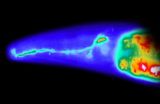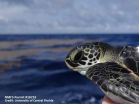INFORMATION:
For more information, contact Bond at nab3met@uw.edu or 206-526-6459 and Hartmann at dhartm@uw.edu or 206-543-7460.
'Warm blob' in Pacific Ocean linked to weird weather across the US
2015-04-09
(Press-News.org) The one common element in recent weather has been oddness. The West Coast has been warm and parched; the East Coast has been cold and snowed under. Fish are swimming into new waters, and hungry seals are washing up on California beaches.
A long-lived patch of warm water off the West Coast, about 1 to 4 degrees Celsius (2 to 7 degrees Fahrenheit) above normal, is part of what's wreaking much of this mayhem, according to two University of Washington papers to appear in Geophysical Research Letters, a journal of the American Geophysical Union.
"In the fall of 2013 and early 2014 we started to notice a big, almost circular mass of water that just didn't cool off as much as it usually did, so by spring of 2014 it was warmer than we had ever seen it for that time of year," said Nick Bond, a climate scientist at the UW-based Joint Institute for the Study of the Atmosphere and Ocean, a joint research center of the UW and the U.S. National Oceanic and Atmospheric Administration.
Bond coined the term "the blob" last June in his monthly newsletter as Washington's state climatologist. He said the huge patch of water - 1,000 miles in each direction and 300 feet deep - had contributed to Washington's mild 2014 winter and might signal a warmer summer.
Ten months later, the blob is still off our shores, now squished up against the coast and extending about 1,000 miles offshore from Mexico up through Alaska, with water about 2 degrees Celsius (3.6 degrees Fahrenheit) warmer than normal. Bond says all the models point to it continuing through the end of this year.
The new study explores the blob's origins. It finds that it relates to a persistent high-pressure ridge that caused a calmer ocean during the past two winters, so less heat was lost to cold air above. The warmer temperatures we see now aren't due to more heating, but less winter cooling.
Co-authors on the paper are Meghan Cronin at NOAA in Seattle and a UW affiliate professor of oceanography, Nate Mantua at NOAA in Santa Cruz and Howard Freeland at Canada's Department of Fisheries and Oceans.
The authors look at how the blob is affecting West Coast marine life. They find fish sightings in unusual places, supporting recent reports that West Coast marine ecosystems are suffering and the food web is being disrupted by warm, less nutrient-rich Pacific Ocean water.
The blob's influence also extends inland. As air passes over warmer water and reaches the coast it brings more heat and less snow, which the paper shows helped cause current drought conditions in California, Oregon and Washington.
The blob is just one element of a broader pattern in the Pacific Ocean whose influence reaches much further - possibly to include two bone-chilling winters in the Eastern U.S.
A study in the same journal by Dennis Hartmann, a UW professor of atmospheric sciences, looks at the Pacific Ocean's relationship to the cold 2013-14 winter in the central and eastern United States.
Despite all the talk about the "polar vortex," Hartmann argues we need to look south to understand why so much cold air went shooting down into Chicago and Boston.
His study shows a decadal-scale pattern in the tropical Pacific Ocean linked with changes in the North Pacific, called the North Pacific mode, that sent atmospheric waves snaking along the globe to bring warm and dry air to the West Coast and very cold, wet air to the central and eastern states.
"Lately this mode seems to have emerged as second to the El Niño Southern Oscillation in terms of driving the long-term variability, especially over North America," Hartmann said.
In a blog post last month, Hartmann focused on the more recent winter of 2014-15 and argues that, once again, the root cause was surface temperatures in the tropical Pacific.
That pattern, which also causes the blob, seems to have become stronger since about 1980 and lately has elbowed out the Pacific Decadal Oscillation to become second only to El Niño in its influence on global weather patterns.
"It's an interesting question if that's just natural variability happening or if there's something changing about how the Pacific Ocean decadal variability behaves," Hartmann said. "I don't think we know the answer. Maybe it will go away quickly and we won't talk about it anymore, but if it persists for a third year, then we'll know something really unusual is going on."
Bond says that although the blob does not seem to be caused by climate change, it has many of the same effects for West Coast weather.
"This is a taste of what the ocean will be like in future decades," Bond said. "It wasn't caused by global warming, but it's producing conditions that we think are going to be more common with global warming."
ELSE PRESS RELEASES FROM THIS DATE:
Dealing with death in deployment
2015-04-09
April 9, 2015 - A new University of Utah study is the first to provide clear insight into contributors to suicide risk among military personnel and veterans who have deployed.
The study, published today in the journal Suicide and Life-Threatening Behavior, found that exposure to killing and death while deployed is connected to suicide risk. Previous studies that looked solely at the relationship between deployment and suicide risk without assessing for exposure to killing and death have shown inconsistent results.
"Many people assume that deployment equals exposure ...
Flip-flopping black holes spin to the end of the dance
2015-04-09
When black holes tango, one massive partner spins head over heels (or in this case heels over head) until the merger is complete, said researchers at Rochester Institute of Technology in a paper published in Physical Review Letters.
This spin dynamic may affect the growth of black holes surrounded by accretion disks and alter galactic and supermassive binary black holes, leading to observational effects, according to RIT scientists Carlos Lousto and James Healy.
The authors of the study will present their findings at the American Physical Society meeting in Baltimore ...
NASA sees Tropical Cyclone Joalane's winds consolidate around its eye
2015-04-09
The RapidScat instrument that flies aboard the International Space Station (ISS) provided data about Tropical Cyclone Joalane's surface winds that showed how the strongest sustained winds consolidated as the tropical cyclone intensified and developed an eye. As of April 9, warnings were in effect at Rodrigues Island in the Southern Indian Ocean as Joalane approached.
RapidScat measured the surface winds within Tropical Cyclone Joalane late on April 7 and on April 8, revealing that the strongest winds consolidated over a 24 hour period. RapidScat measured Joalane's winds ...
In the sea, a deadly form of leukemia is catching
2015-04-09
Outbreaks of leukemia that have devastated some populations of soft-shell clams along the east coast of North America for decades can be explained by the spread of cancerous tumor cells from one clam to another. Researchers call the discovery, reported in the Cell Press journal Cell on April 9, 2015, "beyond surprising."
"The evidence indicates that the tumor cells themselves are contagious--that the cells can spread from one animal to another in the ocean," said Stephen Goff of the Howard Hughes Medical Institute and Columbia University. "We know this must be true because ...
Brain activity in infants predicts language outcomes in autism spectrum disorder
2015-04-09
Autism spectrum disorder (ASD) can produce strikingly different clinical outcomes in young children, with some having strong conversation abilities and others not talking at all. A study published by Cell Press April 9th in Neuron reveals the reason: At the very first signs of possible autism in infants and toddlers, neural activity in language-sensitive brain regions is already similar to normal in those ASD toddlers who eventually go on to develop good language ability but nearly absent in those who later have a poor language outcome.
"Why some toddlers with ASD get ...
Stem cell disease model clarifies bone cancer trigger
2015-04-09
Using induced pluripotent stem cells (iPSCs), a team led by Mount Sinai researchers has gained new insight into genetic changes that may turn a well known anti-cancer signaling gene into a driver of risk for bone cancers, where the survival rate has not improved in 40 years despite treatment advances.
The study results, published today in the journal Cell, revolve around iPSCs, which since their 2006 discovery have enabled researchers to coax mature (fully differentiated) bodily cells (e.g. skin cells) to become like embryonic stem cells. Such cells are pluripotent, able ...
How the brain balances risk-taking and learning
2015-04-09
LA JOLLA--If you had 10 chances to roll a die, would you rather be guaranteed to receive $5 for every roll ($50 total) or take the risk of winning $100 if you only roll a six?
Most animals, from roundworms to humans, prefer the more predictable situation when it comes to securing resources for survival, such as food. Now, Salk scientists have discovered the basis for how animals balance learning and risk-taking behavior to get to a more predictable environment. The research reveals new details on the function of two chemical signals critical to human behavior: dopamine--responsible ...
Mutation causes mice to behave as if they have an eating disorder
2015-04-09
A genetic mutation associated with an increased risk of developing eating disorders in humans has now been found to cause several behavioral abnormalities in mice that are similar to those seen in people with anorexia nervosa. The findings, published online April 9 in Cell Reports, may point to novel treatments to reverse behavioral problems associated with disordered eating.
"It's been known for a long time that about 50% to 70% of the risk of getting an eating disorder was inherited, but the identity of the genes that mediate this risk is unknown," explains senior author ...
Touch-sensing neurons are multitaskers
2015-04-09
Two types of touch information -- the feel of an object and the position of an animal's limb -- have long been thought to flow into the brain via different channels and be integrated in sophisticated processing regions. Now, with help from a specially devised mechanical exoskeleton that positioned monkeys' hands in different postures, Johns Hopkins researchers have challenged that view. In a paper published in the April 22 issue of Neuron, they present evidence that the two types of information are integrated as soon as they reach the brain by sense-processing brain cells ...
Ocean myth busted: 'Toddler' sea turtles are very active swimmers
2015-04-09
It turns out sea turtles, even at a tender 6-18 months of age, are very active swimmers. They don't just passively drift in ocean currents as researchers once thought. NOAA and University of Central Florida researchers say it's an important new clue in the sea turtle "lost years" mystery. Where exactly turtles travel in their first years of life, before returning to coastal areas as adults to forage and reproduce, has puzzled scientists for decades.
"All species of sea turtles are endangered or threatened under the Endangered Species Act; knowing their distribution is ...




